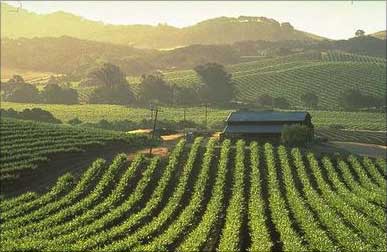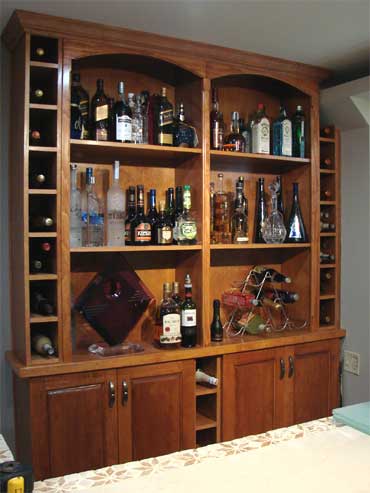 | « Back to article | Print this article |
High time India raises a toast to wine
Next time you visit your neighbourhood coffee shop to grab your cuppa, don't be surprised if you're offered a glass of Cabernet Sauvignon or Chenin Blanc instead.
UB group company Four Seasons Wines has signed an agreement with Barista Lavazza to sell wines through their outlets across India.
This move is an effort to help consumers differentiate between wine and other alcohol. The company wants wine to be perceived as an anytime drink like coffee and tea.
In December 2009, Sula wines had formed a similar partnership with Barista in order to reach a wider audience.
These wine companies are hoping that easy availability at Cafes will help wine shed its elite status and come closer to the masses. This is a challenge that the Indian wine industry has been grappling with for some time.
Despite rosy projections - India has been declared one of the top 10 leading growth nations in the world for wine - the fact remains that wine in India is not seen as an approachable beverage.
High costs and lack of awareness are seen as the main reasons for this perception. Advertising restrictions on alcohol add to the dilemma of the nascent Indian wine industry which is still trying to find its feet in a country where alcohol does not have very positive social and religious connotations.
Click on NEXT to read more...
High time India raises a toast to wine
India has over 50,000 hectares under grape cultivation with the domestic wine industry producing around 1.5 million cases of wine in a year.
The total consumption of wine is also around 1.5 million cases annually out of which imported wine consumption is 0.2 million cases Future projections sound great with Wine and Spirit Research Association based in London, predicting that Indian Wine Industry will grow ten times over the next 10 years , but these should be taken with a pinch of salt.
As is the case with many other sectors in India today, a small base and a large population makes any forecast look good.
The annual per capita consumption of wine in India today is 7ml which is dismal compared to other wine drinking nations.
The traditional wine drinking countries like France and Italy have a per capita consumption of over 50 litres.
Closer home, China, which has emerged as one of the most attractive markets for wine today has a per capita consumption of 10 litres. The total wine consumption in China is touching a100 million cases which is almost 70 times more than India.
But once the right perspective is achieved and we see beyond the hype of India being one of the biggest growth nations for wine, some of the facts and figures do look encouraging.
Click on NEXT to read more...
High time India raises a toast to wine
There are enough socio-economic factors to suggest a bright future for the Indian wine industry. The biggest of them is the demographic dividend.
Only 25 million Indians drink wine currently. Over 50 per cent of India's 1.2 billion population is under 25 years - so there's a large potential audience for wine drinking.
Recent trend shows the increasingly health conscious Indian youth gravitating towards wine because of its perceived benefits.
This is also one of the reasons that almost 70 per cent of wine consumed in India today is Red, since Red wine's role in improving one's health is much talked about.
Another social factor that goes in favour of wine is that it is seen as a 'softer' form of alcohol and even women drinking wine is not frowned upon.
Moreover, it is also a drink that lends itself more easily to a family environment.
These are the factors that the wine companies are trying to capitalise on in their marketing efforts.
Promoting wine tourism is one such initiative. Most wineries are creating tasting rooms with attached restaurants at the vineyards.
Sula Wines has a lovely bungalow for rent at their sprawling property in Nashik and Chateau Indage has a wine themed resort at the outskirts of the city.
Many others have plans to start resorts and spas in the vineyards to boost wine tourism and thereby awareness about this hedonic derivative of grape juice.
Click on NEXT to read more...
High time India raises a toast to wine
UB has a Four Seasons Wine Trail, activity designed to grow wine awareness and consumption.
If you can collect 50 people, the company will conduct a free program that takes you on a brief journey into the world of wines, along with a wine appreciation cum tasting session.
Abhay Kewadkar, chief wine maker and business head, United Spirits Ltd (wines), says, "The consumption of wine today is limited to metros and Tier I cities. We would like to take wine distribution to Tier II and Tier III cities and support this with process of education."
But the challenges of marketing a relatively new and expensive beverage are many.
In most wine drinking countries, the food and wine pairing to enhance the dining experience is one of the main marketing tools adopted by winemakers, but the concept has not taken off in India yet.
Says Myles Myall, wine buyer and educator with The Wine Society of India, "Indian food does not lend itself to being paired with wine so well because of a lack of course structure in Indian food.
Many different dishes are served and eaten together. Though many restaurants are changing that and serving food in different courses, it will take some time before the Indian consumer gets used to having different wines at various stages of their meal."
However, Mayall goes on to explain how a grassy Sauvignon Blanc can lift a Biryani to a different level and how a Chardonnay with Butter Chicken can totally blow you away.
Another reason for food and wine pairing not being popular in India is that like other alcohol, wine is also seen as an aperitif - to be had before the meal.
Click on NEXT to read more...
High time India raises a toast to wine
Another issue is lack of proper storage at most retail outlets which has an adverse effect on the taste and quality of wine. Says Mayall, "Wine needs to be treated like milk. Improper storage at high temperatures can destroy its structure and make it unsuitable for drinking."
Though the retail infrastructure is improving with the emergence of supermarkets around the country, these are still few and far between. This is the reason the Wine Society of India plans to deliver temperature controlled wines to the doorsteps of its members.
The high cost of wine is another hurdle in the way of its popularity with the masses. Where imported wines suffer from duties and taxes finally amounting to almost 200 per cent, the domestic industry suffers from high cost of market entry in states other than home state of the winery.
To overcome this obstacle, the industry has suggested that since wine is a farmer-friendly low- alcohol product that has health benefits, it should be seen as an agro-based industry rather than an alcohol based one.
States like Maharashtra and Karnataka have been giving sops and subsidies and some other states are following suit with wine friendly policies.
This in turn has led to mushrooming of many small wineries, specially in Maharashtra.
In 2000, there were only six wineries in India. Today, there are 65, with a majority of them in Maharashtra.
Click on NEXT to read more...
High time India raises a toast to wine
In 2008, this number was even larger. But with global economic meltdown and the resulting fall in consumption by both domestic and foreign tourists many small wineries were forced to shut shop.
Some industry insiders believe that one of the reasons for a large number of wineries being set up is that the barriers to entry in this trade are very low.
The total capital required to set up a winery is about Rs 2 crore (Rs 20 million).
The glamour value is very high and that has led to some inexperienced people jumping into the trade.
But slowly as the market matures and the price-quality balance becomes a key factor, the value of experience and expertise is being realized. This is not to say that there is no place for small wineries.
Boutique wineries like York in Maharashtra are already making a name for themselves for their lovingly handcrafted wines that are moderately priced.
But if you want to be in this industry, you have to have the patience and sustaining power to be able to reap the rewards.
In other words, a winery in India today is a long term investment rather than one which can give immediate returns.
Wine drinkers in India today constitute less than one percent of the country's population.
But given the growing Indian middle class with higher disposable incomes, better exposure to the outside world, fast expanding young population and higher social acceptability for wine, the inflection point may not be very far away.




